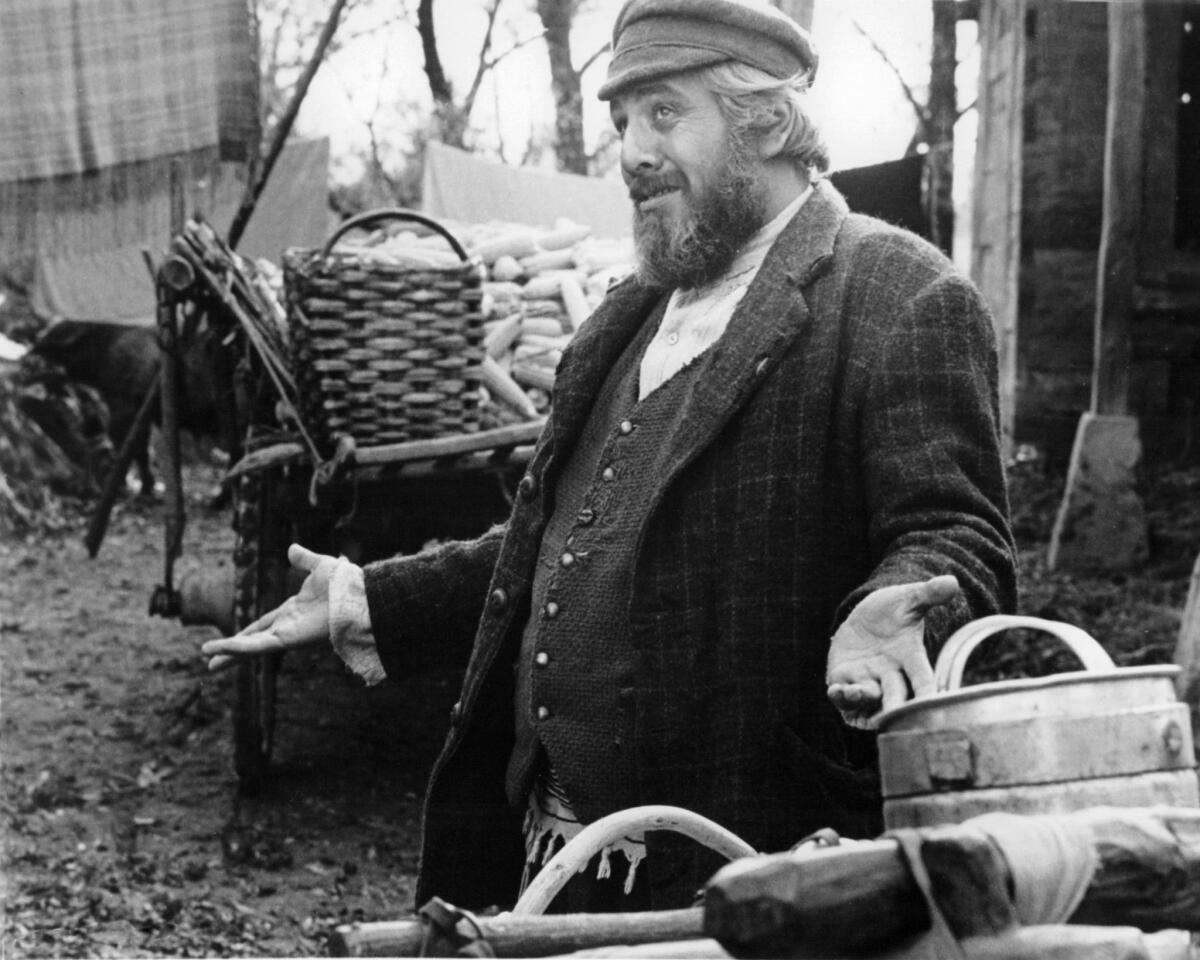‘Fiddler on the Roof’s’ universal themes still resonate after 50 years

On Sept. 22, 1964, after the long-awaited Broadway opening of “Fiddler on the Roof,” invited guests gathered at New York’s swank Rainbow Room to celebrate. The first review that came in that night was from Herald Tribune critic Walter Kerr, and it wasn’t very good. But producer Harold Prince read it aloud to his guests anyway.
“I can’t resist reading this to you,” he said that night, “because it’s so irrelevant.”
Apparently so. Nearly eight years and 3,300 performances later, “Fiddler” became the longest-running show on Broadway. Winner of nine Tony Awards including best musical, “Fiddler” was still on Broadway when United Artists released Norman Jewison’s film of the same name in 1971.
Rarely offstage, rarely on hiatus, “Fiddler on the Roof,” has already been back on Broadway for four revivals, played London’s West End four times and remains among Broadway’s 16 longest-running shows ever. As it celebrates its 50th anniversary, there have been stage productions all over the world — including 15 in Finland alone — as well as in thousands of schools, community centers and regional theaters.
“‘Fiddler on the Roof’ re-created musical theater,” says Tony-winning set designer Robin Wagner. “Until ‘Fiddler,’ musicals spoke only to the immediate generation. ‘Fiddler’ showed how a musical could speak to all generations and cultures.”
Yet “Fiddler” began quite simply, a work of passion by three Broadway veterans seeking their next project.
In fall 1960, a friend sent lyricist Sheldon Harnick a copy of Sholem Aleichem’s 1909 novel “Wandering Stars” with the notion it might make a good musical. Harnick loved it, and so did his longtime collaborator, composer Jerry Bock, with whom he’d written the score for “Fiorello!,” the Tony-winning musical about former New York Mayor Fiorello H. LaGuardia.
When the two men took the idea to playwright Joseph Stein, he told them it was far too sprawling a story. Stein, however, countered with Yiddish humorist Aleichem’s short stories of Tevye the milkman, which Stein’s Poland-born father had read to him in Yiddish when he was a boy and which he thought had better odds as a musical. All three men said the more they read the stories, the more excited they got. And in March 1961, they had their first formal meeting to talk about it.
Never mind that the project resonated with their Jewish heritage and came from their hearts. Even Prince, who was their first choice to produce it, turned them down initially, and so did other producers, one of them even asking what they would do when they ran out of Hadassah audiences.
“We had no idea what would happen to this project,” said Bock. “What was special about it was our personal connection to the material.”
That connection surely bolstered them through several years of work and frustration. When Jerome Robbins came in to shape and direct the show, they did what composers, lyricists and librettists have always done — they rewrote. Through rehearsals and tryouts in Detroit and Washington, D.C., Robbins was their fourth author as they turned what Prince calls “a simple folk tale” into an American classic.
Stein turned out five drafts of the show’s book, and the songwriters came up with about 50 songs, of which the show used fewer than one-third. Again and again, Robbins asked them what the show was really about, and the director didn’t stop until Sheldon Harnick finally said, “It’s about tradition.” Robbins replied, “That’s it. Write that,” and so they did.
“Fiddler’s” groundbreaking opening number, “Tradition,” replaced “We’ve Never Missed a Sabbath Yet,” a song replete with references to plucking chickens and baking challah. Also scrapped along the way were such songs as “A Butcher’s Soul” and “Dear Sweet Sewing Machine.”
“Do You Love Me?” Tevye’s query of his skeptical wife, Golde, emerged in Detroit, while Robbins’ inimitable Bottle Dance took shape in Washington, D.C.
While their first Tevye, Zero Mostel, often sprinkled too much shtick over his performances, sometimes squeezing Tevye’s wet rags over the orchestra pit or joking with an audience member in the front row, he was clearly a comic genius. The show’s first review in Detroit was dismissive of everything and everyone else, yet Mostel was praised as “extraordinary” and in New York, Newsweek’s cover headline was “Hail the Conquering Zero.”
The day after Walter Kerr’s lukewarm review, favorable word of mouth was offered by the rest of the critics. Ticket sales didn’t flag, and on July 21, 1971, just a few months before the “Fiddler” film’s premiere, the show became the longest-running musical on Broadway. Prince’s office reported that “Fiddler” had already returned nearly $7 million on its original $375,000 capitalization. Six other performers had succeeded Mostel as Tevye on Broadway, and the show had played 32 countries from Spain to Rhodesia.
As “Fiddler” traveled the world, few countries embraced the show more than Japan. Its first performance there, in 1967, has been followed by hundreds more over the years. Playwright Stein, who had been worried about how the show would be received there, said their first Japanese producer asked him if they understood the show in America. “When I responded, ‘Why do you ask?’ recalled Stein, “He said, ‘Because it’s so Japanese.’”
In much the same way that “The Diary of Anne Frank” is not just a Jewish story, neither is “Fiddler on the Roof.” “Fiddler’s” strong themes of tradition, repression, prejudice and diaspora continue to evoke common ground for audiences — wherever they are. The well-crafted book and memorable songs don’t hurt, of course, but they are augmented by a plot that has something for everyone, whether it’s the importance of family, friction between generations or the difficult choices that accompany emigration and assimilation.
The universality and timelessness are captured in Norman Jewison’s movie, which has also traveled the world since its 1971 release. Production designer Robert Boyle created 1905 Anatevka in the villages of Yugoslavia, and the large cast represented 10 nationalities. Cinematographer Oswald Morris shot through women’s stockings to get the film’s earthen colors and textures.
While the film’s star, Chaim Topol, says 1 billion people have seen the movie by now, Jewison had many challenges making the film. First he worried that he wasn’t Jewish — although his agent reminded him that he wasn’t black yet made the Oscar-winning “In the Heat of the Night” — and then he anguished over casting.
Convinced that Mostel was “too big” for the role onscreen, Jewison was besieged by phone calls from actors and agents, and among performers expressing interest were Walter Matthau, Danny Kaye and, says Jewison, even Frank Sinatra. But from the moment he first saw Topol play Tevye on a London stage, Jewison had found his Tevye. “Chaim Topol breathed life into Tevye,” he told the audience at a 2011 “Fiddler” screening in New York.
For Frank Rich, former New York Times drama critic, the creators of “Fiddler on the Roof” similarly breathed new life into the American musical. Director-choreographer Robbins and producer Prince, working separately and together, “redefined the musical to dramatize such serious concerns as the street gangs of ‘West Side Story,’ the semi-psychotic mother of ‘Gypsy,’ and the pogroms of ‘Fiddler on the Roof,’” observes Rich. “‘Fiddler,’ coming last, ended the Broadway supremacy of escapist hit musicals like ‘Funny Girl’ and ‘Hello, Dolly!’”
Will “Fiddler on the Roof” still move audiences in 50 more years? Actor Harvey Fierstein thinks so. “I’ve played the show in San Francisco, Fort Worth, Atlanta and Toronto. I’ve played it all over, and the reaction is the same. When I was on Broadway, I’d look out into the house and there would be Hasidic Jews and nuns or maybe a high school cheerleader team in town for a competition, and they all sat with rapt attention watching it. They all got it. The day the boys finished writing it and put it up on the stage, it was part of our culture.”
Adapted from “Tradition!: The Highly Improbable, Ultimately Triumphant Broadway-to-Hollywood Story of Fiddler on the Roof, The World’s Most Beloved Musical” which will be published by St. Martin’s Press on Tuesday.
Isenberg is a former Times staff writer.
More to Read
The biggest entertainment stories
Get our big stories about Hollywood, film, television, music, arts, culture and more right in your inbox as soon as they publish.
You may occasionally receive promotional content from the Los Angeles Times.










